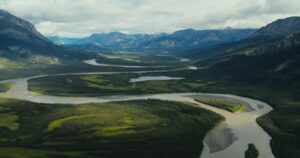In September 2023, a bizarre wave of concentrated seismic upheaval reverberated across the planet for nine days.
The quake baffled seismologists. Most seismic signals are chaotic and brief. These were concerted and prolonged, like sonic energy from “a big musical instrument,” Stephen Hicks, a seismologist at University College London, told Science.
Why?
While there’s still no answer to every question about the nine-day event, researchers now think they’ve discovered its primary cause.
In a yearlong study published this month, Hicks and 67 co-authors spell out how a rockslide in a Greenland fjord caused a local tsunami that triggered the worldwide echo. The research demanded a concerted effort between local sources and seismology field leaders scattered across the globe.
On Sept. 16, 2023, an enormous chunk of ice and rock cut loose from a glacier bed above eastern Greenland’s Dickson Fjord. The slide measured some 25 million cubic meters, about 10 times the volume of the Great Pyramid of Giza, Quanta Magazine reported. It tore through the glacier bed and wiped out historic Inuit archaeological sites and 20th-century trapper hunts.

Before and after the 2023 rockfall. Initial wave height is marked in yellow, tsunami in white. Photo: Soren Rysgaard/Danish army
When it escaped out the glacier’s mouth at 160kmph and thundered into the ocean, the splash was immense. Waves crested at 200m and flooded a military outpost on Ella Island, 72 km away. (Quanta reported nobody was injured or killed, but that the island is now “far smaller.”)
The event shook the planet. Instruments built to detect secret nuclear weapons tests registered it in Russia, 3,300 km away.
Then the strange humming phenomenon began.
Trapped wave?
Seismic signals usually dissipate reliably because of the laws of physics and basic inertia. Waves eventually weaken as they broadcast, feedback decreases, and the disturbance settles out. But in this case, seismic waves kept echoing across the planet, despite a Danish navy survey three days after the collapse that found no further disturbance.
Detective work into subterranean phenomena commenced. One theory was that the concussion might have caused significant ice melt, which then forced water through natural caverns under the glacier. This could turn the glacial piping into the geological equivalent of a musical instrument.
But eventually, the 68 scientists landed on a prevailing theory: a seiche wave.
In a seiche wave, water gets trapped in wave motion, bouncing back and forth in a contained space. It’s common in lakes and harbors. One seiche wave in Lake Erie, Michigan swept several beachgoers into the water in 2013.
However, multiple angles of inquiry failed to substantiate the theory, including an experiment in one scientist’s bathtub. Finally, computer modeling with equipment from the Danish navy persuaded the group. Water in a seiche wave could only escape Dickson Fjord gradually, via small channels, so a wave could get trapped for longer than average.
Amazingly, the researchers found that the wave had depleted to just a few centimeters high after three days. That was strong enough to continue the “song” and slight enough to trick the Danish site surveyors.
The Dickson Fjord event is rare but not unprecedented. Shockwaves rumbled for 18 days after the titanic, 9.1 magnitude Sumatra-Andaman earthquake and tsunami in December 2004. And consensus suggests that after the Chicxulub asteroid annihilated the dinosaurs 66 million years ago, it shook the earth for months.






